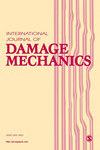用于加成制造 18Ni300 钢 LCF 寿命预测的应变能密度与整个断裂面参数的关系
IF 3.9
2区 工程技术
Q2 MATERIALS SCIENCE, MULTIDISCIPLINARY
引用次数: 0
摘要
本研究探讨了暴露于低循环疲劳加载的快速成型马氏体时效钢的总应变能密度与断裂表面形貌之间的联系。试样采用激光束粉末熔床(LB-PBF)制造,并在应变振幅为 0.3% 至 1.0% 的完全反向应变控制设置下进行检测。使用非接触式三维表面形貌测量系统和整个断裂面方法对死后断裂面进行了研究。重点是以总应变能密度表示的疲劳特性与以面积、体积和分形维度因子表示的断裂表面形貌特征之间的关系。提出了一个基于总应变能密度和断裂表面形貌参数的疲劳寿命预测模型。所提出的模型与疲劳测试结果吻合良好,优于其他基于应变能密度的现有模型。该模型可用于工程元件在低循环疲劳条件下的失效后分析,尤其适用于通过增材制造(AM)生产的材料。本文章由计算机程序翻译,如有差异,请以英文原文为准。
Strain energy density and entire fracture surface parameters relationship for LCF life prediction of additively manufactured 18Ni300 steel
In this study, the connection between total strain energy density and fracture surface topography is investigated in additively manufactured maraging steel exposed to low-cycle fatigue loading. The specimens were fabricated using laser beam powder bed fusion (LB-PBF) and examined under fully-reversed strain-controlled setup at strain amplitudes scale from 0.3% to 1.0%. The post-mortem fracture surfaces were explored using a non-contact 3D surface topography measuring system and the entire fracture surface method. The focus is on the relationship between fatigue characteristics, expressed by the total strain energy density, and the fracture surface topography features, represented by areal, volume, and fractal dimension factors. A fatigue life prediction model based on total strain energy density and fracture surface topography parameters is proposed. The presented model shows good accordance with fatigue test results and outperforms other existing models based on the strain energy density. This model can be useful for post-failure analysis of engineering elements under low-cycle fatigue, especially for materials produced by additive manufacturing (AM).
求助全文
通过发布文献求助,成功后即可免费获取论文全文。
去求助
来源期刊

International Journal of Damage Mechanics
工程技术-材料科学:综合
CiteScore
8.70
自引率
26.20%
发文量
48
审稿时长
5.4 months
期刊介绍:
Featuring original, peer-reviewed papers by leading specialists from around the world, the International Journal of Damage Mechanics covers new developments in the science and engineering of fracture and damage mechanics.
Devoted to the prompt publication of original papers reporting the results of experimental or theoretical work on any aspect of research in the mechanics of fracture and damage assessment, the journal provides an effective mechanism to disseminate information not only within the research community but also between the reseach laboratory and industrial design department.
The journal also promotes and contributes to development of the concept of damage mechanics. This journal is a member of the Committee on Publication Ethics (COPE).
 求助内容:
求助内容: 应助结果提醒方式:
应助结果提醒方式:


